Street & Racing Technology
Street & Racing Technology (commonly called SRT) is a high-performance automobile group within Stellantis North America. SRT began in 1989 as "Team Viper" to develop the Dodge Viper.[1] It later merged with "Team Prowler", the developers of the Plymouth Prowler, to become "Specialty Vehicle Engineering" (SVE). This was renamed "Performance Vehicle Operations" (PVO) from January 2002 till 2004.[3] Since all PVO vehicles used the "SRT" brand, the development team itself was renamed SRT in 2004. SRT heavily tunes and produces vehicles for the Chrysler, Dodge, and Jeep brands.
| Formerly | Team Viper |
|---|---|
| Type | Division |
| Industry | Automotive |
| Fate | Absorbed under Dodge |
| Founded | 1989 (as "Team Viper")[1][2] |
| Founder | Chrysler |
| Headquarters | , |
Area served | United States |
Key people | Ralph Gilles President and CEO |
| Products | Performance Vehicles |
| Owner | Stellantis North America |
| Parent | Chrysler |
Overview
The naming convention used by SRT for its models is indicative of the vehicle's engine type. The number that follows the "SRT" prefix denotes the number of engine cylinders. For example: the Chrysler 300C SRT8 has a 6.1 liter Hemi V-8; Therefore, the SRT version is known as the Chrysler 300C SRT-8. Similarly, the Dodge Viper SRT-10 along with the Dodge Ram SRT-10 had an 8.3 L V-10.
Currently the fastest SRT production models are the 2018 Dodge Challenger Demon with a quarter mile time of 9.65 seconds, the 2021 Dodge Challenger SRT Super Stock with a quarter mile time of 11.5 seconds, the 2021 Dodge Charger SRT Hellcat Redeye with a quarter mile time of 10.6 seconds, the 2015 Dodge Charger Hellcat with a quarter mile time of 11.0 seconds, the 2013 Dodge Viper with a quarter mile time of 11.1 seconds, the 2015 Challenger Hellcat with a quarter mile time of 11.2 seconds, the Dodge Durango SRT Hellcat with a quarter mile time of 11.5 seconds, the Jeep Grand Cherokee Trackhawk with a quarter mile time of 11.5, and the Dodge Challenger R/T Scat Pack 1320 with a quarter mile time of 11.7 seconds. Other SRT models have recorded quarter mile performances, from 12.8 seconds[4] for the AMG-based Chrysler Crossfire SRT-6 to the Dodge Neon SRT-4 at 13.9 seconds.
Chrysler released the 6.4L Hemi engine in early 2011. 2011-2014 SRT-8 versions have 392 HEMI (6.4L) engine, rated at 470 hp (350 kW) and 470 lb⋅ft (637 N⋅m).[5]
The new engine is used in the 2012 Dodge Challenger SRT8, Dodge Charger SRT8, Chrysler 300 SRT8 and the Jeep Grand Cherokee SRT8. With the improved engine, current SRT8 model are not only faster than the previous model, but also has better fuel efficiency than the previous one.
In 2012 Chrysler[6] implemented a plan to turn SRT into a separate brand under the Chrysler Group umbrella.[7] During the 2013 and 2014 model years, the Dodge Viper was sold under the model name SRT Viper. In May 2014, the SRT brand was re-consolidated under Dodge, with former SRT CEO Ralph Gilles continuing as senior vice president of product design and also as the CEO and president of Motorsports.[8]
In late 2014, Chrysler announced a new variant of the Dodge Challenger and Charger models named "SRT Hellcat" and another variant called the "SRT Demon" in early 2017.
Current vehicles
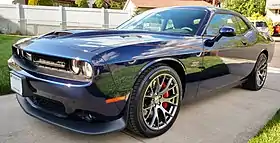 Dodge Challenger SRT 392
Dodge Challenger SRT 392 Dodge Charger SRT 392
Dodge Charger SRT 392.jpg.webp) Jeep Grand Cherokee
Jeep Grand Cherokee Dodge Challenger SRT Hellcat
Dodge Challenger SRT Hellcat
The current lineup from SRT are the Chrysler 300 SRT, Dodge Challenger SRT 392, Dodge Challenger SRT Hellcat, Dodge Challenger SRT Demon, the second generation facelifted Dodge Charger SRT 392, Dodge Charger SRT Hellcat, Jeep Grand Cherokee SRT,the facelifted Dodge Durango SRT[9] and Jeep Grand Cherokee Trackhawk. As for the Chrysler 300 SRT, the car is only sold in Australia, New Zealand, and the Middle East, whereas the US version has been discontinued.
| Vehicle | Model Years | Engine | Power | 0–60 mph (0–97 km/h) | Quarter Mile |
|---|---|---|---|---|---|
| Chrysler 300 SRT
(second generation, Australia, New Zealand & Middle East) |
2011–present | 6.4L naturally aspirated Apache HEMI V8 | 470 hp (350 kW; 477 PS) | 4.0 seconds | --- |
| Dodge Challenger SRT 392
(after facelift) |
2015-2018 | 485 hp (362 kW; 492 PS) | 4.5 seconds[10] | 12.6 seconds | |
| Dodge Charger SRT 392
(second generation LD, after facelift) |
4.6 seconds[11] | 12.8 seconds | |||
| Jeep Grand Cherokee SRT
(fourth generation WK2, after facelift) |
2014–present | 470 hp (350 kW; 477 PS) ('14)
475 hp (354 kW; 482 PS) ('15–present) |
4.4 seconds[12] | 13.0 seconds | |
| Dodge Durango SRT 392 | 2018–present | 475 hp (354 kW; 482 PS) | 4.4 seconds | 12.9 seconds | |
| Jeep Wrangler 392 | 2021-present | 470 hp (350 kW; 477 PS) | 4.5 seconds | 12.9 seconds | |
| Dodge Challenger SRT Hellcat | 2015–present | 6.2L supercharged Hellcat HEMI V8 | 707 hp (527 kW; 717 PS) | 3.6 seconds[13] | 11.2 seconds |
| Dodge Charger SRT Hellcat | 3.6 seconds[14] | 11.0 seconds | |||
| Jeep Grand Cherokee Trackhawk
(fourth generation WK2) |
2018–present | 3.5 seconds[15] | 11.6 seconds | ||
| Dodge Durango SRT Hellcat | 2021–2021 | 710 hp (529 kW; 719 PS) | 3.5 seconds | 11.5 seconds | |
| Ram 1500 TRX | 2021–present | 702 hp | 4.5 seconds | 12.9 seconds | |
| Dodge Challenger SRT Demon | 2017-2018 (Limited to 3,500 cars) | 6.2L supercharged Demon HEMI V8 | 840 hp (626 kW; 852 PS) | 2.3 seconds | 9.65 seconds |
Previous vehicles
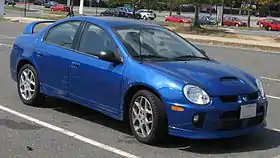 Dodge Neon SRT-4
Dodge Neon SRT-4 Dodge Caliber SRT-4
Dodge Caliber SRT-4 Chrysler Crossfire SRT-6
Chrysler Crossfire SRT-6 Chrysler 300C SRT-8
Chrysler 300C SRT-8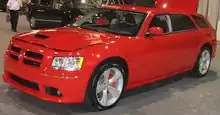 Dodge Magnum SRT-8
Dodge Magnum SRT-8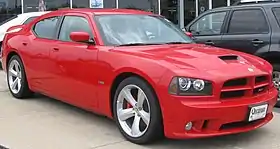 Dodge Charger SRT-8
Dodge Charger SRT-8 Jeep Grand Cherokee SRT-8
Jeep Grand Cherokee SRT-8 Dodge Challenger SRT-8
Dodge Challenger SRT-8.jpg.webp) Chrysler 300 SRT
Chrysler 300 SRT Dodge Charger SRT-8
Dodge Charger SRT-8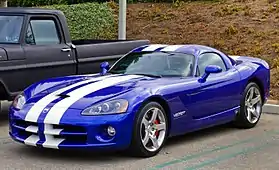 Dodge Viper SRT-10
Dodge Viper SRT-10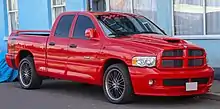 Dodge Ram SRT-10
Dodge Ram SRT-10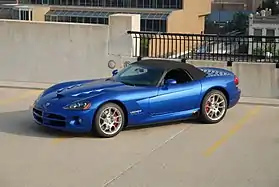 Dodge Viper SRT-10
Dodge Viper SRT-10 Dodge Viper
Dodge Viper
| Vehicle | Model Years | Type | Engine | Power | 0–60 mph (0–97 km/h) | Quarter Mile |
|---|---|---|---|---|---|---|
| Dodge Neon SRT-4 | 2003-2005 | SRT-4 | 2.4-liter turbocharged Inline-4 | 215 hp (160 kW; 218 PS) ('03)
230 hp (172 kW; 233 PS) ('04-05) |
5.6 seconds ('03)[16] 5.3 seconds ('04-05)[17] |
14.2 seconds ('03) 13.9 seconds ('04-05) |
| Dodge Caliber SRT-4 | 2008-2009 | 2.4-liter turbocharged World Inline-4 | 285 hp (213 kW; 289 PS) | 6.2 seconds[18] | 14.6 seconds | |
| Chrysler Crossfire SRT-6 | 2005-2006 | SRT-6 | 3.2-liter Mercedes-AMG M112 V6 | 350 hp (261 kW; 355 PS) | 4.8 seconds[19] | 12.8 seconds |
| Chrysler 300C SRT-8
(first generation) |
2005-2010 | SRT-8 | 6.1-liter naturally aspirated HEMI V8 | 425 hp (317 kW; 431 PS) | 4.7 seconds[20] | 13.2 seconds |
| Dodge Magnum SRT-8 | 2005-2008 | 5.6 seconds[21] | 13.7 seconds | |||
| Dodge Charger SRT-8
(first generation LX) |
2006-2010 | 5.4 seconds[22] | 13.5 seconds | |||
| Jeep Grand Cherokee SRT-8
(third generation WK) |
420 hp (313 kW; 426 PS) | 5.2 seconds[23] | ||||
| Dodge Challenger SRT-8
(before facelift) |
2008-2014 | 6.1-liter naturally aspirated V8 ('08-10)
6.4-liter naturally aspirated V8 ('11-14) |
425 hp (317 kW; 431 PS)
470 hp (350 kW; 480 PS) |
5.3 seconds[24] ('08-10)
4.5 seconds ('11-14) |
13.6 seconds ('08-10)
12.9 seconds ('11-14) | |
| Chrysler 300 SRT-8
(second generation, US version) |
2011-2015 | 6.4-liter naturally aspirated Apache HEMI V8 | 470 hp (350 kW; 477 PS) | 4.0 seconds | --- | |
| Dodge Charger SRT-8
(second generation LD, before facelift) |
2012-2014 | 4.6 seconds | 12.8 seconds | |||
| Jeep Grand Cherokee SRT-8
(fourth generation WK2, before facelift) |
2012-2013 | 4.6 seconds[25] | 13.3 seconds | |||
| Dodge Viper SRT-10
(third generation ZB I) |
2003-2007 | SRT-10 | 8.3-liter naturally aspirated Viper V10 | 500 hp (373 kW; 507 PS) | 3.7 seconds | 11.7 seconds |
| Dodge Ram SRT-10 | 2004-2006 | 5.4 seconds[26] | 13.8 seconds | |||
| Dodge Viper SRT-10
(fourth generation ZB II) |
2008-2010 | 8.4-liter naturally aspirated Viper V10 | 600 hp (447 kW; 608 PS) | 3.8 seconds | 10.9 seconds | |
| Dodge Viper SRT | 2013-2017 | SRT | 640 hp (477 kW; 649 PS) ('12-14)
645 hp (481 kW; 654 PS) ('15-17) |
3.5 seconds | 11.5 seconds |
Future and concept vehicles
In terms of future cars, the only car to be considered for the future is the SRT Tomahawk, which is a Vision Gran Turismo car. The car's projected production start is around the year 2035, but SRT is waiting until technology catches up so they can produce the car, since the car shows what "supercars could look like in 20 years".
Manufacturer engines
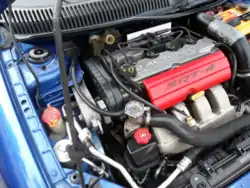
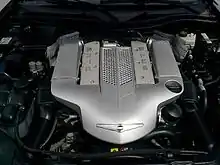
_-_6.4L_392_Hemi_V8_Engine_-_1.jpg.webp)
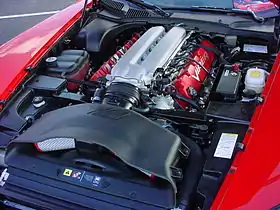
SRT has made six engines so far, and one derived engine. Their first two engines were the third generation ZB I's 8.3-liter naturally aspirated Viper V10 and the Neon SRT-4's 2.4-liter turbocharged Inline-4.
4-cylinder engines
SRT's 2.4-liter turbocharged Inline-4 for the Neon SRT-4 had produced 215 hp (160 kW; 218 PS) in 2003 and 230 hp (172 kW; 233 PS) later in 2004 and 2005. Another 2.4-liter inline-4 was made, but this time was based on the Chrysler World Engine, and was made for the Caliber SRT-4. That engine made 285 hp (213 kW; 289 PS).
6-cylinder engines
The Crossfire SRT-6 never had a SRT-made engine, instead sourcing the M112k engines from Mercedes-Benz, (used in the Mercedes C32 AMG and SLK32 AMG), which produced 350 hp (261 kW; 355 PS).
8-cylinder engines
SRT has built four V8s, which it has applied to five vehicles: Chrysler 300, Dodge Challenger, Dodge Charger, Dodge Magnum and Jeep Grand Cherokee. Their first V8 was a 6.1-liter naturally aspirated HEMI V8 engine that made 425 hp (317 kW; 431 PS). However, the Jeep Grand Cherokee SRT-8 only had 420 hp (313 kW; 426 PS). Their second unit is a 6.4-liter naturally aspirated Apache V8 engine that originally made 470 hp (350 kW; 477 PS) but was upgraded to produce 485 hp (362 kW; 492 PS) after 2014. SRT's most powerful variant is a 6.2-liter supercharged V8, with two separate units used on the Hellcat and Demon models. The Hellcat's version makes 707 hp (527 kW; 717 PS) and the Demon's makes 808 hp (603 kW; 819 PS). On 100-octane fuel, though, the Demon's engine makes 840 hp (626 kW; 852 PS).
10-cylinder engines
SRT's 10-cylinder engines have only been used in two models, the Viper and the Ram 1500 SRT-10. The first unit, an 8.3-liter naturally aspirated Viper V10 had made 500 hp (373 kW; 507 PS). The second unit used a larger bore and stroked 8.4-liter naturally aspirated Viper V10, which increased the power output to 600 hp (447 kW; 608 PS). The last generation Viper used a brand new engine, but still kept the 8.4-liter displacement. The engine produced 640 hp (477 kW; 649 PS), which then increased to 645 hp (481 kW; 654 PS) after the Dodge-SRT absorption.
SRT in China
The Jeep Grand Cherokee SRT-8 is being sold in China by dealer import methods. Due to increasing interest in American muscle cars, dealers are considering also importing the Dodge Charger and Challenger SRT-8 into China.[27]
Chrysler Group leadership changes
After two years of SRT as an independent division, the recently formed Fiat Chrysler Automobiles "FCA" announced on May 4, 2014, that the SRT family of vehicles will be consolidated under the Dodge brand. This includes renaming the "SRT Viper" back again to the legendary "Dodge Viper". This will expand the Dodge lineup to focus it as a performance-dedicated brand.[28]
See also
References
- The Origin Story Of The SRT Brand Revealed by Emma Starr on Hot Cars, Jun 21, 2020
- History on SRT website
- Stone, Matt (May 1, 2004). Viper. Motorbooks. p. 63. ISBN 0760317674.
- "2005 Chrysler Crossfire SRT 6 1/4 mile Drag Racing trap speed 0–60". DragTimes.com. 16 September 2007. Retrieved 10 Sep 2012.
- Kleis, Mark (20 September 2010). "2011 Dodge Challenger's 6.4L HEMI cranks out 475 horsepower!". LeftLaneNews. MNM Media, LLC. Retrieved 10 Sep 2012.
- "First Impressions – Chrysler SRT Brand". MotorWeek. Retrieved 2015-05-22.
- "Jay Leno's Garage: 2013 SRT Viper GTS". Jay Leno's Garage. YouTube. 29 June 2012. Retrieved 10 Sep 2012.
- "Chrysler Group Announces Leadership Changes". Chrysler Group LLC. Retrieved 6 May 2014.
- "Explore the New Jeep® Grand Cherokee SRT - Jeep India". www.jeep-india.com. Retrieved 2019-11-11.
- Robinson, Aaron (December 2010). "2011 Dodge Challenger SRT8 392 – Short Take Road Test". Car and Driver. Retrieved 10 Sep 2012.
- Stone, Matt (10 August 2011). "2012 Dodge Charger SRT8 Full Test and Video". Inside Line. Edmunds. Archived from the original on 3 December 2013. Retrieved 22 May 2015.
- Siler, Steve (January 2017). "2017 Jeep Grand Cherokee SRT". Car and Driver. Retrieved 15 January 2018.
- Sabatani, Jeff (December 2014). "2015 Challenger Hellcat First Look". Car and Driver. Retrieved 23 July 2015.
- Nunez, Alex (August 2014). "2015 Charger Hellcat First Look". Road and Track. Retrieved 23 July 2015.
- Collins, Andrew P. "The Hellcat-Powered 2018 Jeep Trackhawk Is Quicker 0-60 Than The Alfa Giulia". Truck Yeah. Retrieved 2017-07-27.
- Swan, Tony (December 2002). "Dodge Neon SRT-4 – Road Test". Car and Driver. Retrieved 14 September 2012.
- Webster, Larry (April 2004). "Dodge SRT-4 – Short Take Road Test". Car and Driver. Retrieved 14 September 2012.
- Jacobs, Scott (15 September 2009). "Full Test: 2008 Dodge Caliber SRT-4". Inside Line. Edmunds. Retrieved 22 May 2015.
- Hoyer, Mark (24 February 2005). "Hot Sixes – Comparison Test – Where Chrysler takes on Porsche and Nissan...wait, did we say Chrysler?". Road & Track. Archived from the original on 26 October 2012. Retrieved 22 May 2015.
- Quiroga, Tony (June 2005). "Chrysler 300C SRT8 – In baseball talk, this car would be facing a senate subcommittee inquiry". Car and Driver. Retrieved 22 May 2015.
- DiPietro, John (19 October 2005). "Follow-Up Test: 2006 Dodge Magnum SRT-8". Inside Line. Edmunds. Archived from the original on 3 January 2012. Retrieved 22 May 2015.
- Brauer, Karl (25 September 2005). "Follow-Up Test: 2006 Dodge Charger SRT-8". Inside Line. Edmunds. Archived from the original on 3 January 2012. Retrieved 22 May 2015.
- DiPietro, John (9 December 2005). "Follow-Up Test: 2006 Jeep Grand Cherokee SRT8". Inside Line. Edmunds. Archived from the original on 29 August 2012. Retrieved 22 May 2015.
- Kavanagh, Jason (6 August 2009). "Comparison Test: 2010 Camaro SS vs. 2009 Challenger SRT8 vs. 2010 Shelby GT500". Inside Line. Edmunds. Retrieved 14 September 2012.
- Febbo, Michael (12 August 2011). "First Test: 2012 Jeep Grand Cherokee SRT8". Motor Trend. Retrieved 26 Jan 2018.
- Moody, Brian (12 May 2004). "2004 Super Truck Comparison Test: Dodge Ram SRT-10 vs. Ford F-150 SVT Lightning". Inside Line. Edmunds. Retrieved 14 September 2012.
- Zhang, Ning (13 October 2012). "或将引入 道奇Charger国内申报图曝光" (in Chinese). Retrieved 22 May 2015.
- "Chrysler Group Announces Leadership Changes" (Press release). Chrysler Group. 6 May 2014. Retrieved 22 May 2015.
External links
| Wikimedia Commons has media related to Street and Racing Technology. |
Official website (archived, 15 Aug 2011)
